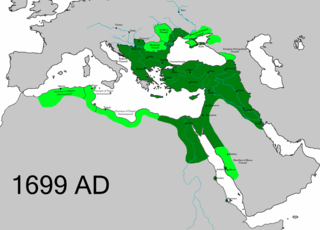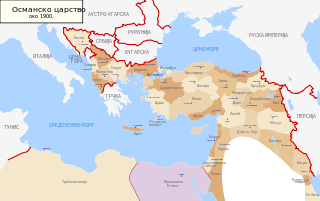
The Ottoman Empire, historically and colloquially the Turkish Empire, was an empire that controlled much of Southeast Europe, Western Asia, and Northern Africa between the 14th and early 20th centuries. It was founded at the end of the 13th century in northwestern Anatolia in the town of Söğüt by the Turkoman tribal leader Osman I. After 1354, the Ottomans crossed into Europe and, with the conquest of the Balkans, the Ottoman beylik was transformed into a transcontinental empire. The Ottomans ended the Byzantine Empire with the conquest of Constantinople in 1453 by Mehmed the Conqueror.

The caliphate of the Ottoman Empire was the claim of the heads of the Turkish Ottoman dynasty to be the caliphs of Islam in the late medieval and the early modern era. During the period of Ottoman expansion, Ottoman rulers claimed caliphal authority after the conquest of Mamluk Egypt by Sultan Selim I in 1517, which bestowed the title of Defender of the Holy Cities of Mecca and Medina upon him and strengthened the Ottoman claim to caliphate in the Muslim world.

The history of the Ottoman Empire in the 18th century has classically been described as one of stagnation and reform. In analogy with 18th-century France, it is also known as the Ancien Régime or Old Regime, contrasting with the "New Regime" of the Nizam-i Cedid and Tanzimat in the 19th century.

The economic history of the Ottoman Empire covers the period 1299–1923. Trade, agriculture, transportation, and religion make up the Ottoman Empire's economy.

The Köprülü era was a period in which the Ottoman Empire's politics were frequently dominated by a series of grand viziers from the Köprülü family. The Köprülü era is sometimes more narrowly defined as the period from 1656 to 1683, as it was during those years that members of the family held the office of grand vizier uninterruptedly, while for the remainder of the period they occupied it only sporadically.
This is a male family tree for all the Ottoman sultans and their wives.
The Institute of Turkish Studies (ITS) is a foundation based in the United States with the avowed objective of advancing Turkish studies at colleges and universities in the United States. Having been founded and provided a grant from the Republic of Turkey in the 1980s, the institute has issued undergraduate scholarships, language study awards, grant money to scholars, and underwritten the holding of workshops. Its work has also attracted controversy by observers who have criticized it as a body held under the sway of the political ideology of the Turkish state, active in the denial of the Armenian genocide and other topics considered taboo, such as the condition of the Kurds in the country.
Donald George Quataert was a historian at Binghamton University. He taught courses on Middle East/Ottoman history, with an interest in labor, social and economics, during the early and modern periods. He also provided training in the reading of Ottoman archival sources.
Nüzül was a tax in the Ottoman Empire.
An emin was an officer in the Ottoman empire; a "steward", the holder of an eminet, and often responsible for customs duties. Unlike a timar holder, an emin was a salaried official. Emins could operate outside the normal Ottoman bureaucracy; they were not necessarily Muslim.
The damga resmi was a form of stamp duty in the Ottoman Empire.
The resm-i bennâk was a tax on peasants who had little or no land - those who did not pay the resm-i çift - in the Ottoman Empire.

This is a bibliography of notable works about the Ottoman Empire.
The çift-hane system was the basic unit of agrarian land holding and taxation in the Ottoman Empire from its beginning. The pre-modern Ottoman system of land tenure was based on the distribution of land between publicly owned lands, miri and privately owned lands mülk, and the majority of the arable land was miri, especially grain-producing land. Peasants were the vast majority of the empire, and they worked as farmers on land designated as miri, relying heavily on wheat-barley production for their subsistence. The peasant household had been the basic form of agrarian production in much of the land ruled by the Ottomans since Roman times, and this had continued through Byzantine rule. So, the çift-hane system was based on the realities which were present in much of the lands the Ottomans conquered: a class of free peasants cultivating their own land, and a taxation policy combining Byzantine, Ottoman, and Islamic rules.

The Ottoman decline thesis or Ottoman decline paradigm is an obsolete historical narrative which once played a dominant role in the study of the history of the Ottoman Empire. According to the decline thesis, following a golden age associated with the reign of Sultan Suleiman the Magnificent, the empire gradually entered into a period of all-encompassing stagnation and decline from which it was never able to recover, lasting until the dissolution of the Ottoman Empire in 1923. This thesis was used throughout most of the twentieth century as the basis of both Western and Republican Turkish understanding of Ottoman history. However, by 1978, historians had begun to reexamine the fundamental assumptions of the decline thesis.

The Transformation of the Ottoman Empire, also known as the Era of Transformation, constitutes a period in the history of the Ottoman Empire from c. 1550 to c. 1700, spanning roughly from the end of the reign of Suleiman the Magnificent to the Treaty of Karlowitz at the conclusion of the War of the Holy League. This period was characterized by numerous dramatic political, social, and economic changes, which resulted in the empire shifting from an expansionist, patrimonial state into a bureaucratic empire based on an ideology of upholding justice and acting as the protector of Sunni Islam. These changes were in large part prompted by a series of political and economic crises in the late 16th and early 17th centuries, resulting from inflation, warfare, and political factionalism. Yet despite these crises the empire remained strong both politically and economically, and continued to adapt to the challenges of a changing world. The 17th century was once characterized as a period of decline for the Ottomans, but since the 1980s historians of the Ottoman Empire have increasingly rejected that characterization, identifying it instead as a period of crisis, adaptation, and transformation.

The Ghaza or Ghazi thesis is a historical paradigm first formulated by Paul Wittek which has been used to interpret the nature of the Ottoman Empire during the earliest period of its history, the fourteenth century, and its subsequent history. The thesis addresses the question of how the Ottomans were able to expand from a small principality on the frontier of the Byzantine Empire into a centralized, intercontinental empire. According to the Ghaza thesis, the Ottomans accomplished this by attracting recruits to fight for them in the name of Islamic holy war against the non-believers. Such a warrior was known in Ottoman Turkish as a ghazi, and thus this thesis sees the early Ottoman state as a "Ghazi State," defined by an ideology of holy war. The Ghaza Thesis dominated early Ottoman historiography throughout much of the twentieth century before coming under increasing criticism beginning in the 1980s. Historians now generally reject the Ghaza Thesis, and consequently the idea that Ottoman expansion was primarily fueled by holy war, but disagree about what hypothesis to replace it with.
Fatma Müge Göçek is a Turkish sociologist and professor at the University of Michigan. She wrote the book Denial of Violence in 2015 concerning the prosectution of Armenians in the Ottoman Empire and Turkey, for which she received the Mary Douglas award for best book from the American Sociological Association. In 2017, she won a Distinguished Faculty Achievement Award from the university.
The Cambridge History of Turkey is a four-volume series on the history of the Ottoman Empire and Republic of Turkey.

Dror Ze'evi is an Israeli historian who studies political, social and cultural history of the Ottoman Empire, Turkey and the Levant.









